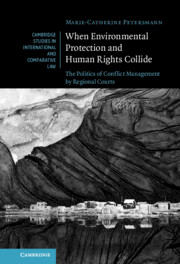 When Environmental Protection and Human Rights Collide
When Environmental Protection and Human Rights Collide Book contents
- When Environmental Protection and Human Rights Collide
- Cambridge Studies in International and Comparative Law 172
- When Environmental Protection and Human Rights Collide
- Copyright page
- Contents
- Acknowledgements
- Table of Cases
- Introduction
- Part I Constructing Synergies: Framing the Environment–Human Rights Interface
- Part II Conflict Mediation through Universalisation
- Conclusion
- Bibliography
- Index
- Cambridge Studies in International and Comparative Law
Conclusion
Published online by Cambridge University Press: 20 October 2022
- When Environmental Protection and Human Rights Collide
- Cambridge Studies in International and Comparative Law 172
- When Environmental Protection and Human Rights Collide
- Copyright page
- Contents
- Acknowledgements
- Table of Cases
- Introduction
- Part I Constructing Synergies: Framing the Environment–Human Rights Interface
- Part II Conflict Mediation through Universalisation
- Conclusion
- Bibliography
- Index
- Cambridge Studies in International and Comparative Law
Summary
This concluding chapter summarises the main arguments and findings of the book. It reflects on the multiple rationales and ideals that were mobilised over time to protect the environment, and translates this protection into an actionable legal framework. It examines the motivations and aims invoked to this end and explores what implications the gradual association of environmental protection with human rights in regional human rights jurisprudence had for the representation of the environment and its relation to human concerns. How are environmental concerns conceptualised, consolidated and contested by human rights courts? Which representations of human and non-human relations lie encoded in the ‘universalisation strategies’ that the book reveals? And what are the political effects of the adoption of environmental concerns in the lexicon of human rights? The conclusion interrogates the world-making effects that the articulation of environmental protection in a human rights register generates and questions the latter’s suitability for radical environmental politics in the Anthropocene. Overall, the book informs us about the management of legal conflicts by courts, the strategies they develop to justify their outcomes and the performative role they play in shaping our understanding of the environment–human rights interface.
Keywords
- Type
- Chapter
- Information
- When Environmental Protection and Human Rights CollideThe Politics of Conflict Management by Regional Courts, pp. 241 - 251Publisher: Cambridge University PressPrint publication year: 2022
